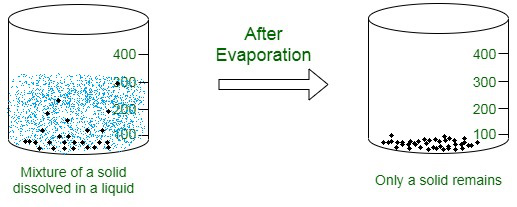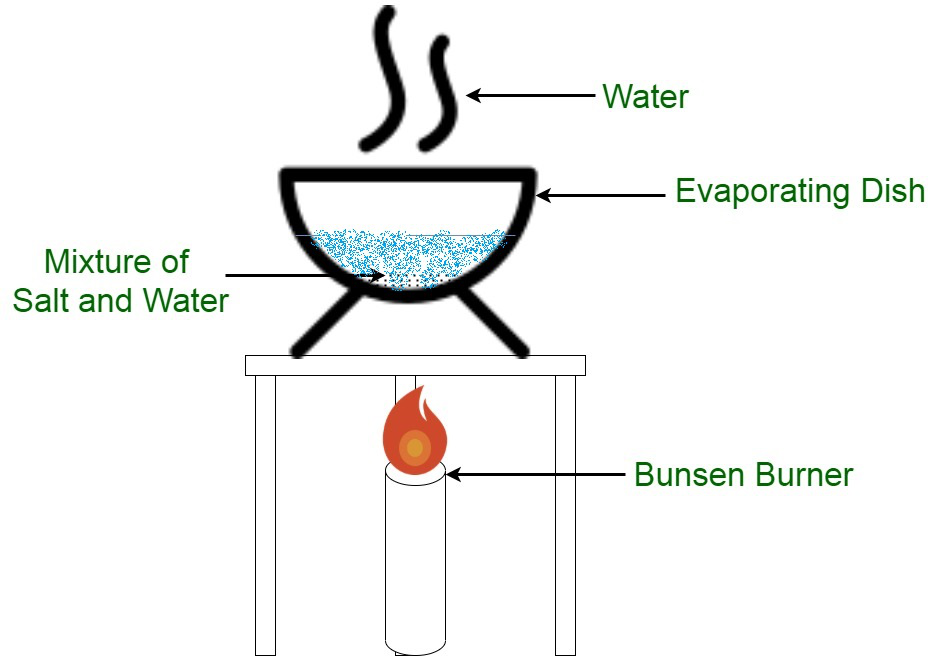蒸发分离
蒸发是分离溶解在水中的固体物质的过程。该应用基于这样一个事实,即固体不易蒸发,而液体则易蒸发。在进行蒸发时,固体物质作为残余物留下。这是一种汽化技术,其中液体变成气相并残留在表面上。
蒸发一直持续到达到平衡状态。然而,在封闭空间中,液体将继续蒸发,直到达到空气饱和。实际上,总分子中只有一小部分拥有蒸发所需的热能。

影响蒸发率的因素
- 压力:较小的压力意味着较高的蒸发速率。在施加较小的压力时,分子不会自行蒸发。
- 物质的温度:当物质的温度升高时,物质会升温,组成粒子开始以更大的动能移动。这导致蒸发速率的增加。例如,热水比冷水沸腾得快。
- 物质的表面:由于任何具有较大表面积的物质每单位体积都会包含更多的表面分子,它会触发粒子逃逸的潜力,从而增加蒸发速率。
- 分子间作用力:液态水分子之间更强的分子间作用力将导致施加更大的作用力以使颗粒逸出。分子间作用力的指标由汽化焓提供。
- 大气的流速:不饱和任何物质的空气,例如新鲜空气,在物质上空盘旋,会导致空气中物质的浓度增加。这增加了蒸发速率。
蒸发平衡
在密闭空间中进行蒸发时,变成蒸气的分子倾向于在液体表面上方积聚。随着液体密度和压力的增加,更多的这些分子返回液体表面。这些返回粒子的频率也有所增加。
平衡时:
蒸发速率与冷凝速率相等。一旦水分子的逸出过程与返回过程相等,逸出的蒸汽就被称为饱和。系统达到平衡状态与物质的蒸气压直接相关的水平此时,以下因素保持不变:
- 蒸汽压力
- 密度
- 会出现液体温度。
Clausius-Clapeyron 关系方便地阐述了这种关系,它强调任何液体的蒸发速率与封闭系统中保持的蒸汽压力有关:

这里,P 1是分别与时间T 1和P 2在T 2相关联的蒸气压。
R是通用气体常数。 ΔH vap被称为汽化焓
蒸发分离的优点
- 浓缩机制造:饮料生产商可以制造浓缩液,例如果汁浓缩机。乳制品生产商还使用蒸发技术将乳糖干燥成粉末
- 可以蒸发含有矿物质的水以提取模拟化学过程的金属和矿物质。这也可以用来提供锅炉给水。
- 海水可以蒸发产生饮用水。
- 它可用于通过蒸发沸腾的混合物来浓缩溶液。
- 从含有混合物的水溶液中除去水,例如氯化钠、氢氧化钠、甘油、胶水和牛奶
蒸发分离的缺点
- 一种物质流失到大气中——其中一种物质通常通过蒸发流失到大气中。蒸汽必须重新冷凝以保存它。
- 该方法不适用于固体不溶于混合物的系统。
- 使系统经受蒸发过程时的热能损失。
蒸发的应用
- 食盐与水的分离:将食盐和水的混合物放入培养皿中并持续加热。当系统达到蒸发状态时,水会从盘子表面逸出,而食盐则留在盘子上。逸出表面的液体无法回收。

- 糖和水的分离:糖和水的混合物可以通过在瓷盘中加热来分离。糖作为残留物留在容器中,而水在加热到平衡点时蒸发。如果使用的溶剂是酒精,糖仍然溶解在水中。
糖水的混合物可以经过蒸发制成冰糖。 - 从硫酸铜溶液中分离硫酸铜晶体:硫酸铜的化合物易溶于水,其晶体溶于水形成硫酸铜溶液。当我们蒸发混合物时,水蒸发掉,固体硫酸铜晶体作为残留物留下。
- 挥发性成分与非挥发性成分的分离。
示例问题
问题 1:说明从硫酸钠溶液中分离钠的完整逐步过程。
回答:
1. A dish is filled with water and few drops of dilute sulphuric acid are added.
2. The water is heated. Upon boiling, the sodium sulphate powder is added while continuous stirring.
3. The powder is added till it stops dissolving further in the mixture.
4. The solution is filtered and left for cooling.
5. The sodium crystals will slowly separate out.
问题2:可以使用蒸发将染料与水分离吗?
回答:
Dye is referred to as the coloured component of the ink. Upon performing evaporation, the coloured part of the ink can be filtered out.
问题3:举一个日常生活中的例子来验证蒸发分离。
回答:
Nail polish applied on the hand evaporates due to the presence of the liquid solution, acetone in it.
问题 4:说明蒸发分离的一个主要缺点。
回答:
It incurs high usage of resources such as capital and energy. It also puts an overhead on the maintenance costs. Difficulty may occur in carrying out the procedure due to large size of apparatus and enhanced temperatures. Some of the other problems are corrosion, scaling as well as foaming.
问题 5. 如何从牛奶中分离水。
回答:
By Measuring the density of milk and separate water by evaporation till the desired density is achieved.
问题 6. 乳制品行业的蒸发是以下哪个过程的预备步骤?
- 烘干
- 调味品
- 浇水
- 巴氏杀菌
回答:
Drying
Dairy industry evaporation is used for concentration duties such as milk, skim milk and whey. It is also used as a preliminary step to drying. Milk products intended for milk powder are normally concentrated from an initial solids content of 9 – 13% to a final concentration of 40 – 50% total solids before the product is pumped to the dryer.
问题 7. 当需要低浓度时,可以使用哪些蒸发器?
回答:
Circulation evaporators can be used when a low degree of concentration is required or when small quantities of product are processed. In yogurt production, for example, evaporation is utilized to concentrate milk 1.1 to 1.25 times, or from 13% to 14.5% or 16.25%solids content respectively. This treatment simultaneously de-aerates the product and rids it off-flavors.